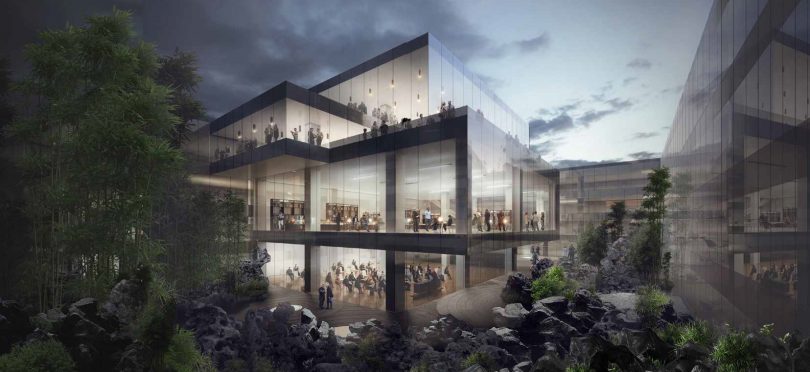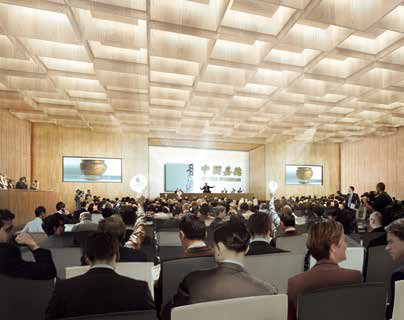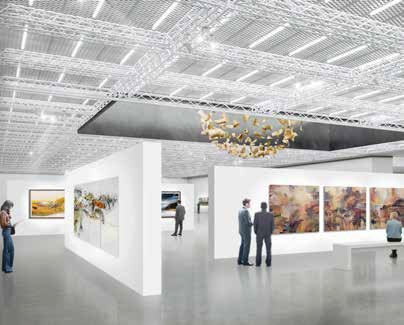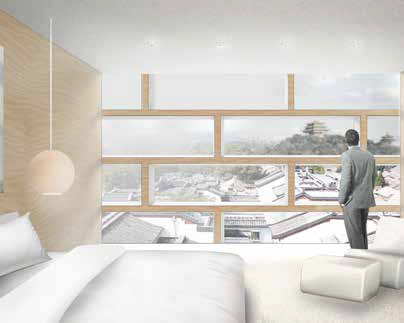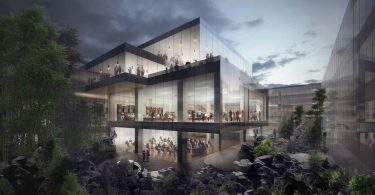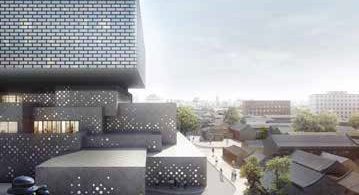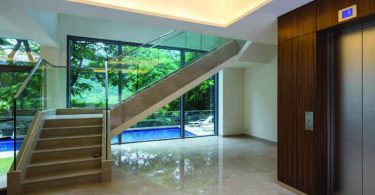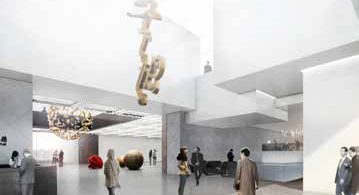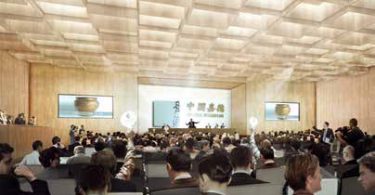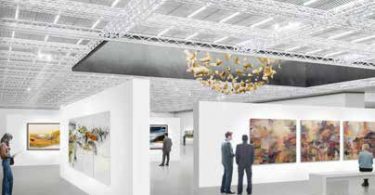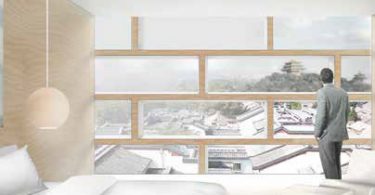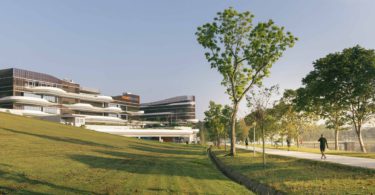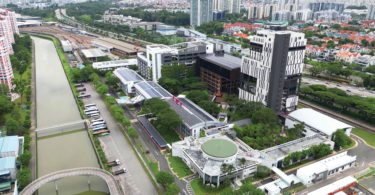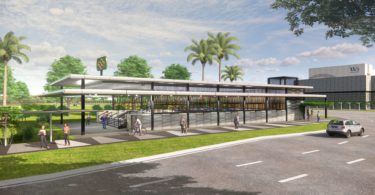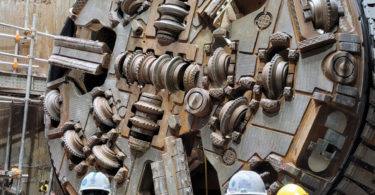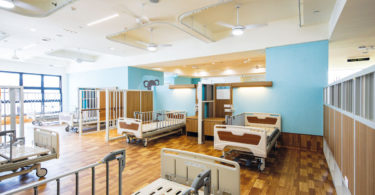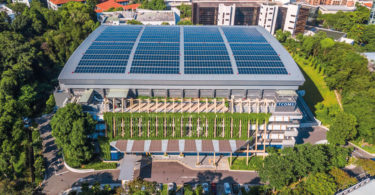Located in close proximity to the Forbidden City on No. 1 Wangfujing Street, at the intersection with Wusi Avenue, the new headquarters for China’s oldest art auction house is symbolically located at the crossroads between commerce (Wangfujing) and culture (Wusi Avenue). Embedded in the historic fabric of central Beijing, the building forms a new hybrid institution between museum, event space and cultural lifestyle centre. The Auction House Headquarters and Cultural Complex were built for the display and exchange of art, carefully embedded within the small-scale historical fabric, while resonating with the surrounding contemporary context.
CULTURAL CENTRE
The auction house is a hybrid between a museum, gallery and market—culture and trading. It links the past, present and future; celebrates and passes on awareness of history and traditions; provides a stage for cultural values: respect and responsibility, valuation and prediction, beauty and meaning; as well as attracts and gathers people as auctions are social events for the appreciation of art and culture. The building acts as a social catalyst for cultural exchange and imagines a home for the arts in a broader sense—a home for its makers (artists) and keepers (collectors).
MUSEUM
At the centre of the building, a 1,700-square-metre column-free exhibition space allows for maximum flexibility and versatility, while expansive exhibition areas on the second floor further extend the museum. Two large auction/exhibition halls in the basement provide a more specific and formal setting, completing the typological variety of spaces. The surrounding matrix of smaller, interconnected rooms of the architectural pixels accommodates support functions and liberates the building’s central halls from secondary obligations.
The building is, at its core, a machine for exhibitions and events. The two main column-free spaces are stacked in the centre of its footprint and enable a multitude of uses—simple, yet versatile ceiling and floor mechanisms provide easy adaptability. These two spaces create a sectional courtyard within the building at the scale of a hangar. They stage and accommodate auctions/exhibitions throughout the seasonal auction calendar, but for most of the year expand the cultural programming into special exhibitions, symposiums and events of diverse nature—a public/private museum with a cultural and educational mission.
Surrounding the central halls is an extended realm of smaller gallery spaces and supplementary support functions. The project navigates between the neutral and the specific, combining aspects of both by providing large-scale spaces that are flexible and convertible, along with a collection of interconnected intimate spaces for specific functions of distinct character. Together, the multiple programmes and circulation through the building give insight and access to the process of art appreciation, education, as well as the study and acquisition of artifacts to a variety of users—from Guardian’s own staff and experts to novices, collector syndicates, art consultants, collectors, artists, and academics.
HYBRID ART SPACE
The Guardian Art Center represents a new hybrid concept for a cultural institution that transcends the traditional definitions of a contemporary art space. Merging the display and presentation of art in its museum spaces with the multifunctional capacities of its exhibition and auction rooms allows virtually any type of usage and event to take place. The seamless integration of several restaurants and a 120-room hotel in the floating ring of the building with views to the Forbidden City creates an encompassing lifestyle concept centred on the experience of art and culture. Through the addition of educational facilities in its central club tower and art conservation departments in its basements, the Guardian Art Center further manifests its position as the world’s first custom designed auction house headquarters and a new hybrid art space.
HISTORY AND MODERNITY
This project is centred on the question of how to synthesise the presence and values of the past with the potentials and realities of the contemporary. The design carefully inscribes the building into its surrounding context, in a sensitive architectural interpretation that fuses history and tradition with a contemporary vision for the future of a cultural art space. The ‘pixelated’ volumes of the lower portion of the building subtly refer to the adjacent historic urban fabric, echoing the grain, colour and intricate scale of Beijing’s hutongs, building upon its surroundings and ‘layering’ into its base the sediments of history. The upper portion of the building responds to the larger scale of the surrounding contemporary city in the form of a floating ‘ring’ that creates an inner courtyard to the building and further resonates with the prevalent typology of the courtyard houses in Beijing. By combining both the intimate and the monumental, and creating a diverse collection of spaces within this structure, the massing integrates itself into the sensitive historical and cultural environment and resonates with Beijing’s strength and imposing presence through an explicitly understated monumentality.
CHINESE-NESS
The building’s façades take on a specific role in its cultural expression and Chinese integration: materiality, colour and texture establish abstract and subtle correspondence with Chinese symbols and meaning. The upper ring of the hotel is made of floating, oversized glass bricks, resonating with the textures of the adjacent hutongs and courtyard houses. In contrast to the imperial motives of the nearby Forbidden City, the brick represents civil society and values—a humble and non-elitist symbol in Chinese culture. The grey stone-like pixels of the lower portion of the building are perforated by several thousand circular openings—generated by projecting one of China’s most important historic landscape paintings, Dwelling in the Fuchun Mountains, onto its façades and thereby creating a subtle light filter through an abstracted landscape silhouette.
The Guardian Art Center creates a new civic destination for arts and culture that fosters the exchange, study and appreciation of cultural artifacts and activities—a vehicle for cultural dissemination and collection, as well as a new centre for art in the heart of Beijing.
PROJECT DATA
Project Name: Guardian Art Center
Location: No.1 Wangfujng Street, Beijing, China
Status: Under construction
Expected Completion: October 2017
Site Area: 6,320 square metres
Net Floor Area: 7,580 square metres (exhibition/auction); 3,400 square metres (offices); 2,050 square metres (restaurants); 150 square metres (café/bookstore); 12,680 square metres (hotel – 120 rooms); 2,000 square metres (club tower); 2,700 square metres (art storage and restoration spaces); 6,750 square metres (parking)
Gross Floor Area: 55,988 square metres (above ground: 29,255 square metres; below ground: 26,733 square metres)
Building Height: 33.6 metres; eight levels above ground, five levels below ground
Client/Owner: China Guardian Auction (Beijing Huangdu Property Development Company Ltd)
Architecture Firm: Buro Ole Scheeren
Design Partner: Ole Scheeren
Management Partner: Eric Chang
Project Leaders: Dan Cheong; Virginia Chiappa Nunez; Lin Wang
Concept Design Team: Jaime Oliver; Paloma Hernaiz; Joseph Tang; Marcel Holmberg; Catarina Canas; Brian Fung
Project Team: Yingda Liu; Michael Cavander; Marcel Holmberg; Emily Liang; Nina Schippel; Olaf Turck; with: Benjamin Ahrens; Kim Bjarke; Catarina Canas; Alicia Casals; Michael Cavander; Jeffrey Cheng; Patrick Conway; Dyno Du; Nicolaz Frez; Brian Fung; Daniel Hawkins; Xinran Ji; Philipp Kramer; Emeline Laurencon; Mavis Liu; Wymen Lo; Max Ma; John Murphey; Marcin Olszowski; Kevin Ou; Kevin Park, Yanyadech Phornphong; Aaron Powers; Klementina Savickaite; Chiara Storino; Joseph Tang; Yang Tao; Elena Yang; Francis Young; Lei Yu; Danny Zhang; Bruno Zhao
Executive Architect: Beijing Institute of Architectural Design (BIAD), Beijing
Mechanical & Electrical Engineer: WSP, Hong Kong/Shanghai
Civil & Structural Engineers: Thornton Tomasetti, New York; Arup, Beijing (Concept)
Executive Engineer: BIAD, Beijing
Façade Consultants: Front Inc, New York/Hong Kong; PFT Construction Consulting, Shanghai
Main Contractor: China Construction Third Engineering Bureau Co Ltd
Images/Photos: Buro Ole Scheeren, Hong Kong/Beijing; SAN, Beijing; Crystal CG, Beijing (computer renderings)


